
W...Y的主页 ?
代码仓库分享?

?前言:
在C++的世界中,有一种数据结构,它不仅像一个神奇的瑰宝匣,还像一位能够在数据的海洋中航行的智慧舵手。这就是C++中的list,一个引人入胜的工具,它以一种优雅而强大的方式管理着数据的舞台。想象一下,你有一个能够轻松操纵、轻松操作的魔法列表,让你的编程之旅变得轻松而令人愉悦。让我们一同揭开list的神秘面纱,深入探索这个双向链表的奇妙世界。
目录
list的介绍及使用
list的介绍
list的使用
list的构造
list iterator的使用
list capacity
list element access
list modifiers
list的模拟实现
模拟实现list的准备
封装节点——第一个封装
创建list类——第二个封装
push_back函数模拟
创建迭代器类——第三个封装
begin与end函数模拟
insert函数模拟实现
erase函数模拟实现
clear函数以及析构函数的实现
其余函数接口的实现
list的介绍及使用
list的介绍
1. list是可以在常数范围内在任意位置进行插入和删除的序列式容器,并且该容器可以前后双向迭代。
2. list的底层是双向链表结构,双向链表中每个元素存储在互不相关的独立节点中,在节点中通过指针指向其前一个元素和后一个元素。
3. list与forward_list非常相似:最主要的不同在于forward_list是单链表,只能朝前迭代,已让其更简单高效。
4. 与其他的序列式容器相比(array,vector,deque),list通常在任意位置进行插入、移除元素的执行效率更好。
5. 与其他序列式容器相比,list和forward_list最大的缺陷是不支持任意位置的随机访问,比如:要访问list的第6个元素,必须从已知的位置(比如头部或者尾部)迭代到该位置,在这段位置上迭代需要线性的时间开销;list还需要一些额外的空间,以保存每个节点的相关联信息(对于存储类型较小元素的大list来说这可能是一个重要的因素)
list的文档介绍  https://legacy.cplusplus.com/reference/list/list/
https://legacy.cplusplus.com/reference/list/list/
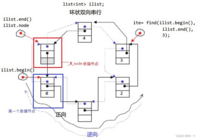
list的使用
list中的接口比较多,此处类似,只需要掌握如何正确的使用,然后再去深入研究背后的原理,已达到可扩展的能力。以下为list中一些常见的重要接口。
list的构造
| 构造函数( (constructor)) | 接口说明 |
| list (size_type n, const value_type& val = value_type()) | 构造的list中包含n个值为val的元素 |
| list() | 构造空的list |
| list (const list& x) | 拷贝构造函数 |
| list (InputIterator first, InputIterator last) | 用[first, last)区间中的元素构造list |
#define _CRT_SECURE_NO_WARNINGS#include <iostream>using namespace std;#include <list>#include <vector>// list的构造void TestList1(){ list<int> l1; // 构造空的l1 list<int> l2(4, 100); // l2中放4个值为100的元素 list<int> l3(l2.begin(), l2.end()); // 用l2的[begin(), end())左闭右开的区间构造l3 list<int> l4(l3); // 用l3拷贝构造l4 // 以数组为迭代器区间构造l5 int array[] = { 16,2,77,29 }; list<int> l5(array, array + sizeof(array) / sizeof(int)); // 列表格式初始化C++11 list<int> l6{ 1,2,3,4,5 };// 用迭代器方式打印l5中的元素 list<int>::iterator it = l5.begin(); while (it != l5.end()) { cout << *it << " "; ++it; } cout << endl; // C++11范围for的方式遍历 for (auto& e : l5) cout << e << " "; cout << endl;}list的构造与STL中vector、string构造大同小异,都是有构造空对象,构造的list中包含n个值为val的元素,拷贝构造以及迭代器构造。
list iterator的使用
此处,大家可暂时将迭代器理解成一个指针,该指针指向list中的某个节点。
| 函数声明 | 接口说明 |
| begin+end | 返回第一个元素的迭代器+返回最后一个元素下一个位置的迭代器 |
| rbegin+rend | 返回第一个元素的reverse_iterator,即end位置,返回最后一个元素下一个位置的reverse_iterator,即begin位置 |
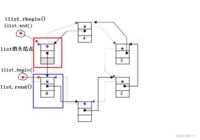
// list迭代器的使用// 注意:遍历链表只能用迭代器和范围forvoid PrintList(const list<int>& l){ // 注意这里调用的是list的 begin() const,返回list的const_iterator对象 for (list<int>::const_iterator it = l.begin(); it != l.end(); ++it) { cout << *it << " "; // *it = 10; 编译不通过 } cout << endl;}void TestList2(){ int array[] = { 1, 2, 3, 4, 5, 6, 7, 8, 9, 0 }; list<int> l(array, array + sizeof(array) / sizeof(array[0])); // 使用正向迭代器正向list中的元素 // list<int>::iterator it = l.begin(); // C++98中语法 auto it = l.begin(); // C++11之后推荐写法 while (it != l.end()) { cout << *it << " "; ++it; } cout << endl; // 使用反向迭代器逆向打印list中的元素 // list<int>::reverse_iterator rit = l.rbegin(); auto rit = l.rbegin(); while (rit != l.rend()) { cout << *rit << " "; ++rit; } cout << endl;} 【注意】
1. begin与end为正向迭代器,对迭代器执行++操作,迭代器向后移动
2. rbegin(end)与rend(begin)为反向迭代器,对迭代器执行++操作,迭代器向前移动
3.迭代器都会提供两个版本,一个是无const修饰的,一个是有const修饰的
list capacity
| 函数声明 | 接口说明 |
| empty | 检测list是否为空,是返回true,否则返回false |
| size | 返回list中有效节点的个数 |

// list::empty#include <iostream>#include <list>int main (){ std::list<int> mylist; int sum (0); for (int i=1;i<=10;++i) mylist.push_back(i); while (!mylist.empty()) { sum += mylist.front(); mylist.pop_front(); } std::cout << "total: " << sum << '\n'; return 0;}
// list::size#include <iostream>#include <list>int main (){ std::list<int> myints; std::cout << "0. size: " << myints.size() << '\n'; for (int i=0; i<10; i++) myints.push_back(i); std::cout << "1. size: " << myints.size() << '\n'; myints.insert (myints.begin(),10,100); std::cout << "2. size: " << myints.size() << '\n'; myints.pop_back(); std::cout << "3. size: " << myints.size() << '\n'; return 0;}这两个函数都是与list中成员有关的函数,我们学会后可以方便快速使用。
list element access
| 函数声明 | 接口说明 |
| front | 返回list的第一个节点中值的引用 |
| back | 返回list的最后一个节点中值的引用 |

// list::front#include <iostream>#include <list>int main (){ std::list<int> mylist; mylist.push_back(77); mylist.push_back(22); // now front equals 77, and back 22 mylist.front() -= mylist.back(); std::cout << "mylist.front() is now " << mylist.front() << '\n'; return 0;}
// list::back#include <iostream>#include <list>int main (){ std::list<int> mylist; mylist.push_back(10); while (mylist.back() != 0) { mylist.push_back ( mylist.back() -1 ); } std::cout << "mylist contains:"; for (std::list<int>::iterator it=mylist.begin(); it!=mylist.end() ; ++it) std::cout << ' ' << *it; std::cout << '\n'; return 0;}list modifiers
| 函数声明 | 接口说明 |
| push_front | 在list首元素前插入值为val的元素 |
| pop_front | 删除list中第一个元素 |
| push_back | 在list尾部插入值为val的元素 |
| pop_back | 删除list中最后一个元素 |
| insert | 在list position 位置中插入值为val的元素 |
| erase | 删除list position位置的元素 |
| swap | 交换两个list中的元素 |
| clear | 清空list中的有效元素 |
// list插入和删除// push_back/pop_back/push_front/pop_frontvoid TestList3(){ int array[] = { 1, 2, 3 }; list<int> L(array, array + sizeof(array) / sizeof(array[0])); // 在list的尾部插入4,头部插入0 L.push_back(4); L.push_front(0); PrintList(L); // 删除list尾部节点和头部节点 L.pop_back(); L.pop_front(); PrintList(L);}// insert /erase void TestList4(){ int array1[] = { 1, 2, 3 }; list<int> L(array1, array1 + sizeof(array1) / sizeof(array1[0])); // 获取链表中第二个节点 auto pos = ++L.begin(); cout << *pos << endl; // 在pos前插入值为4的元素 L.insert(pos, 4); PrintList(L); // 在pos前插入5个值为5的元素 L.insert(pos, 5, 5); PrintList(L); // 在pos前插入[v.begin(), v.end)区间中的元素 vector<int> v{ 7, 8, 9 }; L.insert(pos, v.begin(), v.end()); PrintList(L); // 删除pos位置上的元素 L.erase(pos); PrintList(L); // 删除list中[begin, end)区间中的元素,即删除list中的所有元素 L.erase(L.begin(), L.end()); PrintList(L);}// resize/swap/clearvoid TestList5(){ // 用数组来构造list int array1[] = { 1, 2, 3 }; list<int> l1(array1, array1 + sizeof(array1) / sizeof(array1[0])); PrintList(l1); // 交换l1和l2中的元素 list<int> l2; l1.swap(l2); PrintList(l1); PrintList(l2); // 将l2中的元素清空 l2.clear(); cout << l2.size() << endl;}这些都是list中一些重要接口,我们一定要牢记。list中还有一些操作,需要用到时大家可参阅list的文档说明。
list的模拟实现
模拟实现list的准备
要模拟实现list,必须要熟悉list的底层结构以及其接口的含义,所以我们先从STL源码(SGI版本)开始学习。我们要进行模拟,首先得知道底层的数据类型都有什么。
首先我们知道list是带头双向链表,所以每一处都有一个节点,所以C++肯定会对节点进行封装。
源码中创建了节点的模板,使用struct对节点进行封装处理。因为我们要访问节点,所以使用struct进行类定义而不是class,class默认类部成员都是私有,struct默认类部成员都是公有。
接下来应该看list的结构,看list中的成员变量有什么?
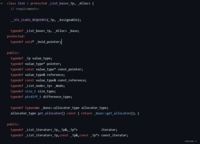 list类中只有一个成员,并且这个成员是节点的指针。
list类中只有一个成员,并且这个成员是节点的指针。
我们已经大致了解了list的类型,接下来我们开始模拟实现list。
封装节点——第一个封装
#include<assert.h>#include<iostream>using namespace std;namespace why{template<class T>struct list_node{list_node<T>* _next;list_node<T>* _prev;T _data;list_node(const T& x = T()):_next(nullptr), _prev(nullptr), _data(x){}};创建一个节点类进行封装, 我们在这里没有源码中那么繁琐,不需要定义空指针进行强制类型转换,而是直接使用list_node<T>*进行指针声明。在这里我们也需要构造函数,默认构造函数对指针不能很好的初始化。
创建list类——第二个封装
template<class T>class list{typedef list_node<T> node;public: typedef __list_iterator<T,T&,T*> iterator; typedef __list_iterator<T, const T&,const T*> const_iterator;list(){_head = new node;_head->_next = _head;_head->_prev = _head;}private: node* _head;};list是一个双向循环链表,所以它只需要一个指针,便可以遍历整个链表并且回到原来的位置。为此我们可以设计一个头节点为list的起始节点,这个头节点不含任何数据,它只是作为一个空的节点而已,所以我们创建一个_head指针作为头节点。
push_back函数模拟
push_back函数是在list的末尾进行插入数据,就与C语言中的数据结构一样进行插入即可。
void push_back(const T& x){node* tail = _head->_prev;//创建新节点node* newnode = new node(x);tail->_next = newnode;newnode->_prev = tail;newnode->_next = _head;_head->_prev = newnode;}
创建一个新节点,让新节点的_prev指向尾部,_next指向头节点。让头节点的_prev指向新节点,尾部节点的_next指向新节点即可。
创建迭代器类——第三个封装
我们现在已经可以将数据尾插到list中去了,但是如何进行遍历打印呢?在list中因为每一个节点的空间是不连续的,所以不能重载[]进行下标访问。而且在string与vector中都使用的是原生指针,所以可以进行++,!=,*()操作,但是在list中却不能使用。因此list的迭代器应该是自定义类型对原生指针的封装,模拟指针的行为,才能有正确的递增,递减,取值,成员取用的行为。
我们需要通过源码进行分析,然后创建一个迭代器的类自己进行重载正确使用。这里推荐大家去看一下源码。
SGI版本list源码 https://github.com/karottc/sgi-stl
https://github.com/karottc/sgi-stl
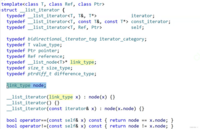
总结如下:
递增:正确的找到其next的地址
递减:正确的找到其prev的地址
取值:当前节点的取值
成员取用:当前节点的成员
template<class T,class Ref,class Ptr>struct __list_iterator{typedef list_node<T> node;typedef __list_iterator<T, Ref,Ptr> self;node* _node;__list_iterator(node* n):_node(n){}Ref& operator*(){return _node->_data;}self operator++(){_node = _node->_next;return *this;}self operator++(int){self tmp(_node);_node = _node->_next;return tmp;}self operator--(){_node = _node->_prev;return *this;}self operator--(int){self tmp(_node);_node = _node->_prev;return tmp;}Ptr operator->(){return &_node->_data;}bool operator!=(const self& s){return _node != s._node;}bool operator==(const self& s){return _node == s._node;}}; 类模板中为什么有三个参数呢?因为*()与->进行重载时会面临两种情况,有无const修饰,所以我们可以通过模板来传递此重载是否有无const。如果不理解这种情况,我们可以分开写有无const的情况,但是这样需要写4种情况,造成代码的冗余。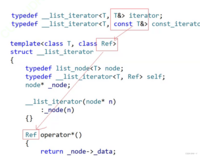
这时我们就可以使用迭代器对list进行遍历打印操作了,可以使用范围for。
void test1(){list<int> ll;ll.push_back(1);ll.push_back(1);ll.push_back(1);ll.push_back(1);list<int>::iterator it = ll.begin();while (it != ll.end()){ cout << *it << ' '; ++it;}cout << endl;}注意:这里我们在给迭代器it赋值时调用了默认拷贝构造函数,因为这里不需要深拷贝。但是在vector,string的情况来说浅拷贝会报错,但是这里为什么没有报错呢?因为在迭代器类中我们并没有写析构函数,所以不会进行多次重复释放空间。
我们这里是不需要写析构函数的,因为迭代器创建的类只是为了更好的适应迭代器的操作,因为list是不连续的空间,我们迭代器指向的空间全部都是节点的,我们只是使用一下而已不需要进行释放操作,释放是list的事情。
begin与end函数模拟
iterator begin(){//iterator it(_head->_next);//return it;return iterator(_head->_next);}const_iterator begin() const{return const_iterator(_head->_next);}iterator end(){return iterator(_head);}const_iterator end() const{//iterator it(_head->_next);//return it;return const_iterator(_head);}begin与end都有两个版本,const与非const。
insert函数模拟实现
插入函数非常简单,在迭代器pos位置进行插入即可。
void insert(iterator pos, const T& x){node* cur = pos._node;node* prev = cur->_prev;node* newnode = new node(x);prev->_next = newnode;newnode->_prev = prev;cur->_prev = newnode;newnode->_next = cur; }将插入的数进行前端后端相连即可。
前面说过,此处大家可将迭代器暂时理解成类似于指针,迭代器失效即迭代器所指向的节点的无效,即该节点被删除了。因为list的底层结构为带头结点的双向循环链表,因此在list中进行插入时是不会导致list的迭代器失效的,只有在删除时才会失效,并且失效的只是指向被删除节点的迭代器,其他迭代器不会受到影响。
erase函数模拟实现
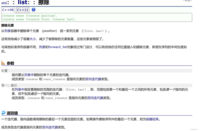
我们可以看出erase是有返回值的,就是避免迭代器失效的原因,而且绝对不能删除哨兵位节点,所以得使用断言。
iterator erase(iterator pos){assert(pos != end());node* prev = pos._node->_prev;node* cur = pos._node->_next;prev->_next = cur;cur->_prev = prev;delete pos._node;return iterator(cur);}写完insert与erase我们就可以对其进行复用,pop_back、pop_front、push_back、push_front就是进行了首插、首删、尾插、尾删。
void pop_back(){erase(--end());}void pop_front(){erase(begin());}void push_back(const T& x){insert(end(), x);}void push_front(const T& x){insert(begin(), x);}clear函数以及析构函数的实现
clear函数就是将list置空,所以我们可以复用erase进行逐一删除即可。
void clear(){iterator it = begin();while (it != end()){ erase(it++);//it = erase(it);}}不能使用erase(it),会导致迭代器失效
析构函数将空间全部释放置空:
~list(){clear();delete _head;_head = nullptr;}其余函数接口的实现
迭代器初始化:
template <class Iterator>list(Iterator first, Iterator last){empty_init();while (first != last){push_back(*first);++first;}}拷贝构造函数:
void swap(list<T>& tmp){std::swap(_head, tmp._head);}list(const list<T>& lt){_head = new node; _head->_next = _head; _head->_prev = _head;list<T> tmp(lt.begin(), lt.end());swap(tmp);}我们使用现代写法进行偷懒,我们使用迭代器初始化一个临时对象tmp,将tmp与目标进行交换即可。
赋值重载构造:
list<int>& operator=(list<T> lt){swap(lt);return *this;}我们使用传值时会进行拷贝构造临时对象lt,将lt与目标进行交换即可,属于窃取劳动成果!
在我们的"C++ List探秘之旅"中,我们像是一群探险者,勇敢地穿越了C++编程的密林,发现了list这个神奇的宝藏。现在,当我们回望这段旅程时,或许你已经领略到了在数据操控的掌声中,list是如何成为代码交响乐团的一部分。这并不是终点,而是一个新的起点。在C++的舞台上,list为你打开了通往更高层次编程乐趣的大门,希望大家可以通过本文走的更高。感谢观看!!!